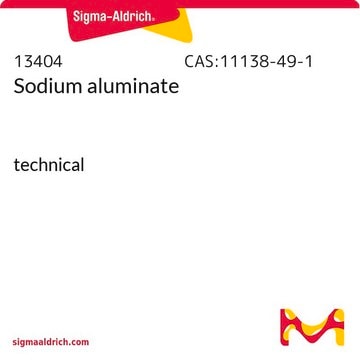307815
Sodium metasilicate
Synonyme(s) :
Disodium metasilicate, Disodium silicate, Sodium silicate, Sodium silicon oxide
About This Item
Produits recommandés
Composition
SiO2, 50-53%
Niveau de qualité
Chaîne SMILES
[Na+].[Na+].[O-][Si]([O-])=O
InChI
1S/2Na.O3Si/c;;1-4(2)3/q2*+1;-2
Clé InChI
NTHWMYGWWRZVTN-UHFFFAOYSA-N
Vous recherchez des produits similaires ? Visite Guide de comparaison des produits
Description générale
Application
- Hydrothermal preparation of thorium uranium silicate (Th1-xUxSiO4) uranothorite solid solutions
- Fabrication of dense NaA zeolite coatings
- Reactant for preparation of tungsten modified silica as catalyst for liquid phase oxidation of styrene
SMS can also be used:
- To prepare NaZnSiO3OH, a novel chiral framework material which has potential application in ion exchange, adsorption and catalysis.
- As a low-cost alternative to tetraethyl orthosilicate (TEOS) to synthesize highly ordered mesoporous silicas.
- To prepare geopolymer concrete.
Mention d'avertissement
Danger
Mentions de danger
Conseils de prudence
Classification des risques
Eye Dam. 1 - Met. Corr. 1 - Skin Corr. 1B - STOT SE 3
Organes cibles
Respiratory system
Code de la classe de stockage
8B - Non-combustible corrosive hazardous materials
Classe de danger pour l'eau (WGK)
WGK 1
Point d'éclair (°F)
Not applicable
Point d'éclair (°C)
Not applicable
Équipement de protection individuelle
Eyeshields, Faceshields, Gloves, type P3 (EN 143) respirator cartridges
Certificats d'analyse (COA)
Recherchez un Certificats d'analyse (COA) en saisissant le numéro de lot du produit. Les numéros de lot figurent sur l'étiquette du produit après les mots "Lot" ou "Batch".
Déjà en possession de ce produit ?
Retrouvez la documentation relative aux produits que vous avez récemment achetés dans la Bibliothèque de documents.
Notre équipe de scientifiques dispose d'une expérience dans tous les secteurs de la recherche, notamment en sciences de la vie, science des matériaux, synthèse chimique, chromatographie, analyse et dans de nombreux autres domaines..
Contacter notre Service technique








